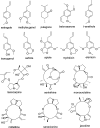Environmental and internal drivers of genotoxic carcinogens accumulation in botanicals and their preparations
- PMID: 40646165
- PMCID: PMC12454579
- DOI: 10.1007/s00204-025-04123-y
Environmental and internal drivers of genotoxic carcinogens accumulation in botanicals and their preparations
Abstract
The use of botanicals and herbal products is increasing globally, especially in developed countries, but their active ingredients are often poorly defined and inconsistently regulated. Moreover, the chemical composition of plants is usually influenced by internal factors (such as genetics, phenology, and age) and external influences (such as environmental conditions). These influences can significantly alter chemical profiles, which is critical for plants used in food, cosmetics, and medicine. Growing concern over harmful compounds in these products highlights the variability in their levels. Specifically, some compounds in plants are known to have genotoxic or carcinogenic effects, and their concentrations can vary greatly depending on these factors. This paper reviews how factors like water stress, soil nutrients, geographic location, and plant development affect the presence of hazardous substances in plants. While genetic factors like chemotypes and cultivars are well-studied, less is known about how environmental and developmental conditions affect chemically uniform plants. Overall, the current work emphasizes the unpredictability of these effects and underscores the need for further research to compare the levels of hazardous compounds in plants against established human safety thresholds, to better assess exposure risks in food, cosmetic and herbal products.
Keywords: Chemotypes; Cultivation methods; Genotoxic carcinogens; Herbal products; Medicinal plants; Phenology.
© 2025. The Author(s).
Conflict of interest statement
Declarations. Conflict of interest: The authors declare that they have no known competing interests.
Figures
References
-
- Acimovic M, Tešević V, Marina T et al (2015) Compositional characteristics of the essential oil of Pimpinella anisum and Foeniculum vulgare grown in Serbia. Botanica Serbica 39:9–14
-
- Alaoui Jamali C, Kasrati A, Bekkouche K et al (2014) Cultivation and the application of inorganic fertilizer modifies essential oil composition in two Moroccan species of Thymus. Ind Crops Prod 62:113–118. 10.1016/j.indcrop.2014.08.017
-
- Al-Gabbiesh A, Hunaiti A, Alkaraki A (2015) Influencing the contents of secondary metabolites in spice and medicinal plants by deliberately applying drought stress during their cultivation. Jordan J Biol Sci 8:1–10. 10.12816/0026941
-
- Aljaiyash A, Kasrati A, Alaoui Jamali C, Chaouch A (2018) Effect of cultivation on chemical composition and bioactivities of essential oils from Artemisia herba-alba Asso grown in Morocco. Biochem Syst Ecol 81:74–79. 10.1016/j.bse.2018.10.001
Publication types
MeSH terms
Substances
LinkOut - more resources
Full Text Sources


